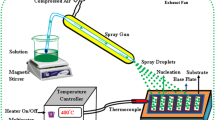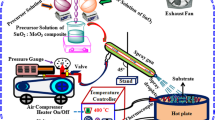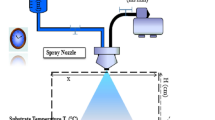Abstract
The composite metal oxide thin films, (1–x)(SnO2)-(x)(Pr2O3) (where x = 0.0, 0.25, 0.50, 0.75, 1.0 at.%), were coated using the laboratory spray pyrolysis method. Their structural, vibrational, morphological, compositional and optical properties were analyzed using X-ray diffraction (XRD), Fourier transform infrared (FTIR) spectroscopy, X-ray photoelectron spectroscopy (XPS), field emission scanning electron microscopy (FE-SEM), energy-dispersive X-ray spectroscopy (EDX), atomic force microscopy (AFM), ultraviolet–visible near-infrared spectroscopy (UV–Vis. NIR) and photoluminescence spectroscopy (PL). XRD studies confirmed that the deposited (1–x)(SnO2)-(x)(Pr2O3) composite thin film adhered to the tetragonal phase for x = 0.0, the hexagonal phase for x = 1.0, and a combined phase for x = 0.25, 0.50, and 0.75 at.%. Additionally, the crystallite size decreased with the addition of rare earth composite. FTIR spectra revealed the basic vibrational modes of Sn–O and Pr–O. XPS analysis disclosed the Sn, Pr, and O chemical valence states, as well as oxygen vacancies on the surface. FESEM analysis showed that the morphology of composite thin films was significantly altered by Pr2O3 content. EDX study revealed the presence of Sn, Pr, and O elements. Root mean square (RMS) roughness values identified through AFM analysis could contribute to enhancing photocatalytic performance. PL analysis revealed the recombination of photo-generated charge carriers, surface, and lattice oxygen defects. The calculated edge potential of the conduction and valence bands in SnO2, Pr2O3, and their composites revealed a defect energy level, which is efficient for visible photocatalytic dye degradation capabilities. A high visible light photocatalytic efficiency of 93%, against methylene blue dye, of the composite thin film (0.50SnO2 − 0.50Pr2O3) is primarily attributed to its extended light absorption capability, appropriate band edge alignment between SnO2 and Pr2O3, minimal electron–hole pair recombination, and efficient charge transfer.









Similar content being viewed by others
Data availability
The data generated during the current study are available from the corresponding author on reasonable request.
References
B. Arumugam, R. JothiRamalingam, S.-M. Chen, S. Subburaj, S. Ramasundaram, H. Al-Lohedan, S.K. Ramaraj, The design of praseodymium galena nanospheres: an effective photocatalyst for the remediation of carcinogenic phenothiazine and chromium contaminants. J. Phys. Chem. Solids 165, 110660 (2022). https://doi.org/10.1016/j.jpcs.2022.110660
N. El Fidha, F. Bitri, S. Chaabouni, F. Acosta, C. Güell, J. Bittencourt, J. Casanova-Chafer, E. Liobet, Physical and photocatalytic properties of sprayed Dy doped ZnO thin films under sunlight irradiation for degrading methylene blue. RSC Adv. 11, 24917–24925 (2011). https://doi.org/10.1039/d1ra03967a
K. Arjunan, R. Ramesh Babu, Facile homemade spray pyrolyzed (SnO2)1–x-(CeO2)x composite thin films for visible light photocatalysis application. Ionics 29, 4797–4816 (2023). https://doi.org/10.1007/s11581-023-05160-24
R.S. Pedanekar, S.K. Shaikh, K.Y. Rajpure, Thin film photocatalysis for environmental remediation: a status review. Curr. Appl. Phys.. Appl. Phys.. 20, 931–952 (2020). https://doi.org/10.1016/j.cap.2020.04.006
I. Loyola Poul Raj, M.S. Revathy, A. Jegatha Christy, N. Chidhambaram, V. Ganesh, S. AlFaif, J. Nanopart. Res.Nanopart. Res. 22, 359 (2020). https://doi.org/10.1007/s11051-020-05084-2
S.A. Ansari, M.M. Khan, M.O. Ansari, J. Lee, M.H. Cho, Visible light-driven photocatalytic and photoelectrochemical studies of Ag-SnO2 nanocomposites synthesized using an electrochemically active bio film. RSC Adv. 4, 26013–26021 (2014). https://doi.org/10.1039/C4RA03448A
F. Joudi, J. Ben Naceur, R. Ouertani, R. Chtourou, A novel strategy to produce compact and adherent thin films of SnO2/TiO2 composites suitable for water splitting and pollutant degradation. J. Mater. Sci. Mater. Electron. 30, 167–179 (2019). https://doi.org/10.1007/s10854-018-0278-4
S. Zarei, M. Hasheminiasari, S.M. Masoudpanah, J. Javadpour, Photocatalytic properties of ZnO/ SnO2 nanocomposite films: role of morphology. J. Mater. Res. Technol. 17, 2305–2312 (2022). https://doi.org/10.1016/j.jmrt.2022.01.12611
J. Kim, S. Wong, G. Kim, Y.-B. Park, J. van Embden, E.D. Gaspera, Transparent electrodes based on spray coated fluorine-doped tin oxide with enhanced optical, electrical and mechanical properties. J. Mater. Chem. C. 8, 14531–14539 (2020). https://doi.org/10.1039/D0TC03314F
A. Arfaoui, N. Mhamdi, S. Besrour, H.I. Touihri, Z.A. Ouzari, M. Alrowaili, Amlouk, Investigations into the physical properties of SnO2/MoO3 and SnO2/WO3 bi- layered structures along with photocatalytic and antibacterial applications. Thin Solid Films 648, 12–20 (2018). https://doi.org/10.1016/j.tsf.2018.01.002
R. Ramanathan, S. Nagarajan, S. Sathiyamoorthy, B. Manavaimaran, H.C. Barshilia, R.C. Mallik, A highly sensitive and room temperature ethanol gas sensor based on spray deposited Sb doped SnO2 thin films. Mater. Adv. 5, 293–305 (2024). https://doi.org/10.1039/D3MA00696D
G.P. Shukla, C.K. Pandey, M. Bajpai, M.C. Bhatnagar, R. Dhar, Ammonia gas sensor based on SnO2 nanostructure with the enhanced sensing capability at low temperatures. Phase Transitions 92, 939–947 (2019). https://doi.org/10.1080/01411594.2019.1660878
Wu. Huizhong, J. Wang, R. Chen, C. Yuan, J. Zhang, Y. Zhang, J. Sheng, F. Dong, Zn-doping mediated formation of oxygen vacancies in SnO2 with unique electronic structure for efficient and stable photocatalytic toluene degradation. Chin. J. Catal.Catal. 42, 1195–1204 (2021). https://doi.org/10.1016/S1872-2067(20)63737-8
A. Mohammad, M.R. Karim, M.E. Khan, M.M. Khan, M.H. Cho, Biofilm-assisted fabrication of Ag @ SnO2-g- C3N4 nanostructures for visible light-induced photocatalysis and photoelectrochemical performance. J. Mater. Chem. C. 123, 20936–20948 (2019). https://doi.org/10.1021/acs.jpcc.9b05105
S. Asaithambi, P. Sakthivel, M. Karuppaiah, G. UdhayaSankar, K. Balamurugan, R. Yuvakkumar, M. Thambidurai, G. Ravi, Investigation of electrochemical properties of various transition metals doped SnO2 spherical nanostructures for supercapacitor applications. J. Energy Storage. 31, 101530 (2020). https://doi.org/10.1016/j.est.2020.101530
T. Xie, M.R. Hasan, B. Qiu, E.S. Arinze, V. Nguyen, A. Motayed, S.M. Thon, R. Debnath, High-performing visible-blind photodetectors based on SnO2/CuO nano heterojunctions. Appl. Phys. Lett. 107, 241108 (2015). https://doi.org/10.1063/1.4938129
J.P.C. Baena, L. Steier, W. Tress, M. Saliba, S. Neutzner, T. Matsui, F. Giordano, T. JesperJacobsson, A.R.S. Kandada, S.M. Zakeeruddin, A. Petrozza, A. Abate, M.K. Nazeeruddin, M. Grätzel, A. Hagfeldt, Highly efficient planar perovskite solar cells through band alignment engineering. Energy Environ. Sci. 8, 2928–2934 (2015). https://doi.org/10.1039/C5EE02608C
P. Gupta, V. Rathore, A comprehensive review: SnO2 for photovoltaic and gas sensor applications. Appl. Innov. Res. 1, 184–193 (2019). https://doi.org/10.56042/air.v1i3-4.28901
S. Asaithambi, P. Sakthivel, M. Karuppaiah, R. Yuvakkumar, D. Velauthapillai, T. Ahamad, M.A. Majeed Khan, M.K.A. Mohammed, N. Vijayaprabhu, G. Ravi, The bifunctional performance analysis of synthesized Ce doped SnO2/g-C3N4 composites for asymmetric supercapacitor and visible light photocatalytic applications. J. Alloys Compd. 866, 158807 (2021). https://doi.org/10.1016/j.jallcom.2021.158807
K. Ozel, A. Yildiz, High-detectivity ultraviolet-B photodetector based on SnO2 thin film/Si heterojunction. Semicond. Sci. Technol.. Sci. Technol. 36, 095001 (2021). https://doi.org/10.1088/1361-6641/ac1051
J. Mazloom, F.E. Ghodsi, F.Z. Tepehan, G.G. Tepehan, I. Turhan, Enhanced lithium electrochemical performance and optical properties of CeO2-SnO2 nanocomposite thin films by transition metal (TM: Ni, Mn and Co) doping. J. Sol-gel Sci. Technol 86, 51–62 (2018). https://doi.org/10.1007/s10971-018-4603-4
X. Sun, T. Zhai, Lu. Xihong, S. Xie, P. Zhang, C. Wang, W. Zhao, P. Liu, Y. Tong, Facile synthesis of Pr(OH)3 nanostructures and their application in water treatment. Mater. Res. Bul 47, 1783–1786 (2012). https://doi.org/10.1016/j.materresbull.2012.03.024
Y. Borchert, P. Sonstrom, M. Wilhelm, H. Borchert, M. Baumer, Nanostructured praseodymium oxide: preparation, structure, and catalytic properties. J. Phys. Chem. C 112, 3054–3063 (2008). https://doi.org/10.1021/jp0768524
F. Gu, S.F. Wang, M.K. Lu, X.F. Cheng, S.W. Liu, G.J. Zhou, D. Xu, D.R. Yuan, Luminescence of SnO2 thin films prepared by spin coating method. J. Cryst. GrowthCryst. Growth 262, 182–185 (2004). https://doi.org/10.1016/j.jcrysgro.2003.10.028
S. Min, J. Jeong, A study of a typical grain growth properties for SnO2 thin films. Mater. Sci. Semicond. Process.Semicond. Process. 16, 1267–1270 (2013). https://doi.org/10.1016/j.mssp.2013.01.026
Y. Liu, E. Koep, M. Liu, A highly sensitive and fast-responding SnO2 sensor fabricated by combustion chemical vapour deposition. Chem. Mater. 17, 3997–4000 (2005). https://doi.org/10.1021/cm0504510
M.A. Gubbins, V. Casey, S.B. Newcomb, Nano structural characterization of SnO2 thin films prepared by reactive RF magnetron sputtering of tin. Thin Solid Films 405, 270–275 (2002). https://doi.org/10.1016/S0040-6090(01)01728-X
Y. Nagasawa, K. Tabata, H. Ohnishi, Sensitivity control of SnO2 by morphology of thin film. Appl. Surf. Sci. 121(122), 327–330 (1997). https://doi.org/10.1016/S0169-4332(97)00317-6
G.E. Patil, D.D. Kajale, D.N. Chavan, N.K. Pawar, P.T. Ahire, S.D. Shinde, V.B. Gaikwad, G.H. Jain, Synthesis, characterization and gas sensing performance of SnO2 thin films prepared by spray pyrolysis. Bull. Mater. Sci. 34, 1–9 (2011). https://doi.org/10.1007/s12034-011-0045-0
S. Chacko, M.J. Bushiri, V.K. Vaidyan, Photoluminescence studies of spray pyrolytically grown nanostructured tin oxide semiconductor thin films on glass substrates. J. Phys. D-Appl. Phys. 39, 4540–4543 (2006). https://doi.org/10.1088/0022-3727/39/21/004
S. Ebrahimiasl, W.M.Z.Q. Yunus, A. Kassim, Z. Zainal, Synthesis of nanocrystalline SnOX (x = 1–2) thin film using a chemical bath deposition method with improved deposition time, temperature and pH. Sensors 11, 9207–9216 (2011). https://doi.org/10.3390/s111009207
E. DE Souza, Z.H. Monteiro, C.V. Santilli, S.H. Pulcinelli, Electrical and optical characteristics of SnO2 thin films prepared by dip coating from aqueous colloidal suspensions. J. Mater. Sci. Mater. Electron. 8, 265–270 (1997). https://doi.org/10.1023/A:1018574903725
S.N. Pusawale, P.R. Deshmukh, C.D. Lokhande, Chemical synthesis of nanocrystalline SnO2 thin films for supercapacitor application. Appl. Surf. Sci. 257, 9498–9502 (2011). https://doi.org/10.1016/j.apsusc.2011.06.043
T. Weisemoeller, F. Bertram, S. Gevers, A. Greuling, C. Deiter, H. Tobergte, M. Neumann, J. Wollschläger, A. Giussani, T. Schroeder, Postdeposition annealing induced transition from hexagonal Pr2O3 to cubic PrO2 films on Si (111). J. Appl. Phys. 105, 124108 (2009). https://doi.org/10.1063/1.3152796
S. Rani, J.R. Anoop, G. Gopal, Meera, Ganesan, V. Pillai, V.P. Mahadevan, Structural and optical characterization of Pr2O3 and Yb doped and co-doped silicon nanorings. Adv. Sci. Eng. Med. 5, 869–876 (2013). https://doi.org/10.1166/asem.2013.1375
R. Lo Nigro, R.G. Toro, G. Malandrino, V. Raineri, I.L. Fragalà, A simple route to the synthesis of Pr2O3 high-k thin films. Adv. Mater. 15, 1071–1075 (2003). https://doi.org/10.1002/adma.200304806
S. Sathasivam, A. Kafizas, S. Ponja, N. Chadwick, D.S. Bhachu, S.M. Bawaked, A.Y. Obaid, S. Al-Thabaiti, S.N. Basahel, C.J. Carmalt, I.P. Parkin, Combinatorial atmospheric pressure CVD of a composite TiO2/SnO2 thin film. Chem. Vap. Depos.Vap. Depos. 20, 69–79 (2014). https://doi.org/10.1002/cvde.201307081
W.R.W. Abdullah, A. Zakaria, M.S.M. Ghazali, Synthesis mechanism of low-voltage praseodymium oxide doped zinc oxide varistor ceramics prepared through modified citrate gel coating. Int. J. Mol. Sci. 13, 5278–5289 (2012). https://doi.org/10.3390/ijms13045278
P.B. Willer, E.T. Marc Daire, Donnees cristallographiques sur la variete B des sequioxydes La2O3 et Pr2O3. Bull. Soc. Fr. Mineral. Cristallogr 92, 33–37 (1969). https://doi.org/10.3406/bulmi.1969.6309
H. Kaur, H.S. Bhatti, K. Singh, Pr doped SnO2 nanostructures: morphology evolution, efficient photocatalysts and fluorescent sensors for the detection of Cd2+ ions in water. J. Photochem. Photobiol. A: Chem 388, 112144 (2020). https://doi.org/10.1016/j.jphotochem.2019.112144
M. Marikkannan, V. Vishnukanthan, A. Vijayshankar, J. Mayandi, J.M. Pearce, A novel synthesis of tin oxide thin films by the sol-gel process for optoelectronic applications. AIP Adv. 5, 027122 (2015). https://doi.org/10.1063/1.4909542
M.K. Trivedi, R.M. Tallapragada, A. Branton, D. Trivedi, G. Nayak, O. Latiyal, S. Jana, Effect of biofield energy treatment on physical and structural properties of calcium carbide and praseodymium oxide. Int. J. Mater. Sci. 4, 390–395 (2015). https://doi.org/10.5281/zenodo.196957
B.V. Ayodele, M.R. Khan, Chin Kui Cheng, Greenhouse gases mitigation by CO2 reforming of methane to hydrogen-rich syngas using praseodymium oxide supported cobalt catalyst. Clean Techn. Environ. Policy. 19, 795–807 (2017). https://doi.org/10.1007/s10098-016-1267-z
J. Ramesh Babu, K. Ravindhranath, K. Vijaya Kumar, Nano-Pr2O3 doped PVA + Na3C6H5O7 polymer electrolyte films for electrochemical cell. Int. J. Polym. Sci. 15, 10 (2018). https://doi.org/10.1155/2018/7906208
F.H. Aragon, I. Gonzalez, J.A.H. Coaquira, P. Hidalgo, H.F. Brito, J.D. Ardisson, W.A.A. Macedo, P.C. Morais, Structural and surface study of praseodymium-doped SnO2 nanoparticles prepared by the polymeric precursor method. J. Phys. Chem. C 119, 8711–8717 (2015). https://doi.org/10.1021/acs.jpcc.5b00761
C. Chen, Y. Li, M. Shen, Structure-related luminescent properties induced by doping in Sm-doped SnO2 hollow spheres. Ceram. Int. 46, 17025–17033 (2020). https://doi.org/10.1016/j.ceramint.2020.03.289
S. Lutkehoff, M. Neumann, A. Slebarski, 3d and 4d x-ray photoelectron spectra of Pr under gradual oxidation. Phys. Rev. B Condens. MatterCondens. Matter 52, 13808–13811 (1995). https://doi.org/10.1103/physrevb.52.13808
P. Makuła, M. Pacia, W. Macyk, How to correctly determine the band gap energy of modified semiconductor photocatalysts based on UV–Vis spectra. J. Phys. Chem. Lett. 9, 6814–6817 (2018). https://doi.org/10.1021/acs.jpclett.8b02892
K. Arjunan, R. Ramesh Babu, Fabrication of samarium doped SnO2 thin films using facile spray pyrolysis technique for photocatalysis application. Ionics 30, 491–507 (2024). https://doi.org/10.1007/s11581-023-05256-9
Y.M. Hunge, A.A. Yadav, S.-W. Kang, S.J. Lim, H. Kim, Visible light activated MoS2/ZnO composites for photocatalytic degradation of ciprofloxacin antibiotic and hydrogen production. J. Photochem. Photobiol. A Chem 434, 114250 (2023). https://doi.org/10.1016/j.jphotochem.2022.114250
A. Murali, Y.P. Lan, P.K. Sarswat, M.L. Free, Synthesis of CeO2/reduced graphene oxide nanocomposite for electrochemical determination of ascorbic acid and dopamine and for photocatalytic applications. Mater. Today Chem. 12, 222–232 (2019). https://doi.org/10.1016/j.mtchem.2019.02.001
P. Fageria, R. Nazir, S. Gangopadhyay, H.C. Barshilia, S. Pande, Graphitic- carbon nitride support for the synthesis of shape-dependent ZnO and their application in visible light photocatalysts. RSC Adv. 5, 80397–80409 (2015). https://doi.org/10.1039/C5RA12463H
J. Gao, J. Xue, S. Jia, Q. Shen, X. Zhang, H. Jia, X. Liu, Q. Li, Y. Wu, Self-doping surface oxygen vacancy-induced lattice strains for enhancing visible light driven photocatalytic H2 evolution over black TiO2. ACSAppl. Mater. Interfaces 13, 18758–18771 (2021). https://doi.org/10.1021/acsami.1c01101
M.A. Marzouk, I.M. Elkashef, A.M. Fayad, H.A. Elbatal, Photoluminescence, optical and structural properties of Pr3+- doped fluorophosphate glasses and their induced defects by gamma irradiation. J. Mater. Sci. Mater. Electron. 29, 10561–10572 (2018). https://doi.org/10.1007/s10854-018-9120-2
R.A. Geioushy, I.M. Hegazy, S.M. El-Sheikh, O.A. Fouad, Construction of 2D MoS2 @ ZnO heterojunction as superior photocatalyst for highly efficient and selective CO2 conversion into liquid fuel. J. Environ. Chem. Eng. 10, 107337 (2022). https://doi.org/10.1016/j.jece.2022.107337
Acknowledgements
The author's KA and RR would like to gratefully acknowledge the National Centre for Photovoltaic Research and Education (NCPRE) at IIT Bombay, funded by the Ministry of New and Renewable Energy, Government of India, for providing a major characterization facility for FESEM, AFM, XPS measurement. The author RR gratefully acknowledges MOE-RUSA 2.0 Physical Sciences for departmental financial support.
Author information
Authors and Affiliations
Contributions
KA was involved in conceptualization, methodology, software, data curation, writing-original draft preparation, visualization, investigation, software, validation. RR was involved in supervision. KA and RR were involved in writing-receiving and editing.
Corresponding author
Ethics declarations
Conflict of interest
The authors announce that they have no known competing financial interests or personal associations that could have appeared to persuade the work presented in this paper.
Additional information
Publisher's Note
Springer Nature remains neutral with regard to jurisdictional claims in published maps and institutional affiliations.
Supplementary Information
Below is the link to the electronic supplementary material.
Rights and permissions
Springer Nature or its licensor (e.g. a society or other partner) holds exclusive rights to this article under a publishing agreement with the author(s) or other rightsholder(s); author self-archiving of the accepted manuscript version of this article is solely governed by the terms of such publishing agreement and applicable law.
About this article
Cite this article
Arjunan, K., Babu, R.R. Visible light photocatalysis application of (1–x)(SnO2) − (x)(Pr2O3) composite thin films by laboratory spray pyrolysis method. Appl. Phys. A 130, 378 (2024). https://doi.org/10.1007/s00339-024-07515-6
Received:
Accepted:
Published:
DOI: https://doi.org/10.1007/s00339-024-07515-6




